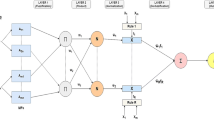Abstract
Complex shapes of plastics can be realized by joining techniques. Newer method of joining of plastics is necessitated by the industries due to the requirement such as reduced processing time and improved strength. Frictional vibration joining of plastics is a newer method where the heat generated by the third body at the interface of joining members is utilized for joining. The present study attempts to use the Taguchi method for frictional vibration joining of plastic plates. The effectiveness of the Taguchi method lies in clarifying the factor that dominates complex interactions in frictional vibration welding. The factors are (1) frequency of tool vibrating across the work piece, (2) feed of the work piece against the tool, and (3) clamping force at the joint interface. This study describes a new method of selection of process parameters for obtaining optimal weld tensile strength. Genetic algorithm was used to optimize the parameters for the process. Artificial neural network (ANN) was used to establish the relationship between the input/output parameters of the process. The established ANN is then suitably integrated with the optimization technique. This hybrid technique of ANN and genetic algorithm is effectively used to obtain optimal joint strength.
Similar content being viewed by others
References
Yarlagadda PKDV, Tan CC (1998) An investigation into welding of engineering thermoplastics using focused microwave energy. J Mater Process Technol 74:199–212. doi:10.1016/S0924-0136(97)00269-0
Coelcho JP, Abreu MA, Pires MC (2000) High-speed laser welding of plastic films. Opt Lasers Eng 34:385–395. doi:10.1016/S0143-8166(00)00071-3
Siores E (1997) Thermoplastic joining using solar energy concentrator. Int J Mach Tools Manuf 37:1273–1279. doi:10.1016/S0890-6955(96)00084-3
Aravindan S, Murti KGK, Krishnamurthy R, Sivananth V (2002) Friction stir welding. National Seminar on Processing and Characterization of Light Structural Materials for Frontier Sectors, Trivendrum, p 53
Schmidt H, Hattel J, Wert J (2004) An analytical model for the heat generation in friction stir welding. Model Simul Mater Sci Eng 12:143–157. doi:10.1088/0965-0393/12/1/013
Russell MJ, Shercliff HR (1999) Analytical modelling of microstructure development in friction stir welding, 1st International Symposium on Friction Stir Welding, Thousand Oaks, California, USA
Davim JP, Reis P (2005) Multiple regression analysis (MRA) in modeling milling of glass fibre reinforced plastics (GFRP). Int J Manuf Technol Manag 6(1–2):185–197
George PM, Raghunath BK, Manocha LM, Warrier AM (2004) EDM machining of carbon–carbon composite—a Taguchi approach. J Mater Process Technol 145:66–71. doi:10.1016/S0924-0136(03)00863-X
Liu S-J, Chen Y-S (2004) The manufacturing of thermoplastic composite parts by water-assisted injection-molding technology. Compos Part A 35:171–180. doi:10.1016/j.compositesa.2003.10.006
Kim D, Rhee S (2003) Optimization of GMA welding process using the dual response approach. Int J Prod Res 41:4505–4515. doi:10.1080/0020754031000/595800
Kim D, Rhee S, Park H (2002) Modelling and optimization of a GMA welding process by genetic algorithm and response surface methodology. Int J Prod Res 40:1699–1711. doi:10.1080/00207540110119964
Panneerselvam K, Aravindan S, Noorul Haq A (2004) Joining of plastic by frictional vibrations. Proceedings of International Symposium of Research Students on Materials Science and Engineering, IIT, Madras, p 66
Panneerselvam K, Aravindan S, Noorul Haq A, Krishnamuthy R (2005) Joining of thermoplastic composites. Journal of Indian Welding Society, 15–19
Author information
Authors and Affiliations
Corresponding author
Rights and permissions
About this article
Cite this article
Panneerselvam, K., Aravindan, S. & Noorul Haq, A. Hybrid of ANN with genetic algorithm for optimization of frictional vibration joining process of plastics. Int J Adv Manuf Technol 42, 669–677 (2009). https://doi.org/10.1007/s00170-008-1641-z
Received:
Accepted:
Published:
Issue Date:
DOI: https://doi.org/10.1007/s00170-008-1641-z




